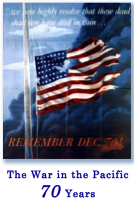
On today's date in 1943 at Espiritu Santo, divers from Dad's repair ship,
Vestal, began an underwater inspection of the light cruiser USS
Denver. Vestal will conduct minor repairs and modifications to the ship until the 22nd.
Launched in April 1942, Denver sailed to the New Hebrides in February 1943. She saw her first of many combat encounters in the bombardment of Kolombangara in the Solomons in March. During this engagement, the task force sank 2 Japanese destroyers.
Continuing her operations in the Solomons, Denver participated the bombardment of Ballale Island in late June, in connection with the invasion of New Georgia that lasted through early August. During the bombardment of Munda on July 11-12, the ship suffered some damage resulting from its own gunfire, compromising the watertight integrity of its main deck. While Denver's own crew repaired the damage, this was likely part of Vestal's inspection and repair that began on today's date.
Early in November, Denver's task force fought to intercept an enemy force contesting the Allied landings on Bougainville in Papua New Guinea. In that battle American ships sank an enemy light cruiser and a destroyer, as well as damaging 2 heavy cruisers and 2 destroyers. During the fight, Denver was hit by 3 enemy shells, which, fortunately, did not explode. She shared in the Navy Unit Commendation for outstanding performance in this battle.
Denver next covered the landings on Cape Torokina on Bougainville in November, and during a heavy air attack, she was torpedoed, knocking out all power and communications and killing 20 of her crew. She was towed back to Espiritu Santo for temporary repairs, then sailed to Mare Island on the West Coast for overhaul.
Denver returned to service at Eniwetok in the Marshall Islands in June 1944. She screened carriers as they launched strikes against Japanese bases during the invasion of the Marianas Islands. She bombarded Iwo Jima in July, and then returned to Eniwetok in August.
In September, Denver sailed for the invasion of the Micronesian island of Palau. There she bombarded Anguar Island, then covered a task unit engaged in minesweeping, reconnaissance, and underwater demolition operations before the landings on Ulithi in late September. In October, Denver supported the landings on Leyte, bombarding islands there to open the invasion fleet's way into Leyte Gulf. That same month Denver's task force saw action in Surigao Strait while preventing the Japanese Southern Force from passing into Leyte Gulf. The attack resulted in the sinking of the flagship Yamashiro. The battleship's admiral, captain, and about 1,600 officers and crew were lost when the ship sunk. The cruiser Mogami was also sunk by American aircraft with a loss of 192 crewmen. After this action, Denver sailed on to finish off crippled enemy ships, aiding in sinking the destroyer Asagumo, which lost 191 of her crew.
Denver continued service in Leyte Gulf through the end of that year. During another October attack, she was damaged by a bomb released from one of the planes she shot down. In November, the cruiser screened reinforcement landings and fought off a kamikaze attack, suffering 4 men wounded from bomb fragments. In December, Denver provided cover for the Philippine landing on Mindoro. She covered other landings in the Philippines through the early months of 1945. From July through August, Denver participated in anti-shipping sweeps off the China coast. With Japan's surrender, the cruiser covered the evacuation of the Allied servicemen rescued from prison camps and covered the landing of occupation troops in Japan.
In November, Denver arrived home on the East Coast. After an overhaul, she served to train men of the Naval Reserve. In April 1946, she was placed out of commission and remained in reserve until February 1947. In 1960, this heroic ship was sold for scrap.
In addition to the Navy Unit Commendation, USS
Denver received 11 Battle Stars for her WWII service.
Sources: War Diaries for USS Vestal & Denver, August 1944; USS Denver Action Report of August 11-12, 1943 NavSource Online; Wikipedia
 In the month of August 1943, while stationed in Espirito Santo, in addition to extensive and continuing repairs to HMAS Hobart, Dad's ship, Vestal, tackled numerous routine repairs to various vessels of the fleet. In relative order of service and repair, these ships included: YFD-21, Celeno, Monogahela, PC-477, SS Matthew Lyon, YMS-97, Denver, Patapsco, Cleveland, LST-448, LST-485. Plus Vestal tended to various shop jobs on ships and at the harbor base.
In the month of August 1943, while stationed in Espirito Santo, in addition to extensive and continuing repairs to HMAS Hobart, Dad's ship, Vestal, tackled numerous routine repairs to various vessels of the fleet. In relative order of service and repair, these ships included: YFD-21, Celeno, Monogahela, PC-477, SS Matthew Lyon, YMS-97, Denver, Patapsco, Cleveland, LST-448, LST-485. Plus Vestal tended to various shop jobs on ships and at the harbor base.

















